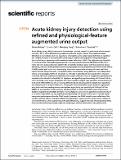Acute kidney injury detection using refined and physiological-feature augmented urine output
Author(s)
Alkhairy, Sahar; Celi, Leo Anthony G.; Feng, Mengling; Zimolzak, Andrew J.
Downloads41598-021-97735-0.pdf (2.506Mb)
Publisher with Creative Commons License
Publisher with Creative Commons License
Creative Commons Attribution
Terms of use
Metadata
Show full item recordAbstract
Acute kidney injury (AKI) is common in the intensive care unit, where it is associated with increased mortality. AKI is often defined using creatinine and urine output criteria. The creatinine-based definition is more reliable but less expedient, whereas the urine output based definition is rapid but less reliable. Our goal is to examine the urine output criterion and augment it with physiological features for better agreement with creatinine-based definitions of AKI. The objectives are threefold: (1) to characterize the baseline agreement of urine output and creatinine definitions of AKI; (2) to refine the urine output criteria to identify the thresholds that best agree with the creatinine-based definition; and (3) to build generalized estimating equation (GEE) and generalized linear mixed-effects (GLME) models with static and time-varying features to improve the accuracy of a near-real-time marker for AKI. We performed a retrospective observational study using data from two independent critical care databases, MIMIC-III and eICU, for critically ill patients who developed AKI in intensive care units. We found that the conventional urine output criterion (6 hr, 0.5 ml/kg/h) has specificity and sensitivity of 0.49 and 0.54 for MIMIC-III database; and specificity and sensitivity of 0.38 and 0.56 for eICU. Secondly, urine output thresholds of 12 hours and 0.6 ml/kg/h have specificity and sensitivity of 0.58 and 0.48 for MIMIC-III; and urine output thresholds of 10 hours and 0.6 ml/kg/h have specificity and sensitivity of 0.49 and 0.48 for eICU. Thirdly, the GEE model of four hours duration augmented with static and time-varying features can achieve a specificity and sensitivity of 0.66 and 0.61 for MIMIC-III; and specificity and sensitivity of 0.66 and 0.64 for eICU. The GLME model of four hours duration augmented with static and time-varying features can achieve a specificity and sensitivity of 0.71 and 0.55 for MIMIC-III; and specificity and sensitivity of 0.66 and 0.60 for eICU. The GEE model has greater performance than the GLME model, however, the GLME model is more reflective of the variables as fixed effects or random effects. The significant improvement in performance, relative to current definitions, when augmenting with patient features, suggest the need of incorporating these features when detecting disease onset and modeling at window-level rather than patient-level.
Date issued
2021-10Department
Massachusetts Institute of Technology. Institute for Medical Engineering & ScienceJournal
Scientific Reports
Publisher
Springer Science and Business Media LLC
Citation
Alkhairy, Sahar et al. "Acute kidney injury detection using refined and physiological-feature augmented urine output." Scientific Reports 11 (October 2021): 19561. © 2021 The Author(s)
Version: Final published version
ISSN
2045-2322